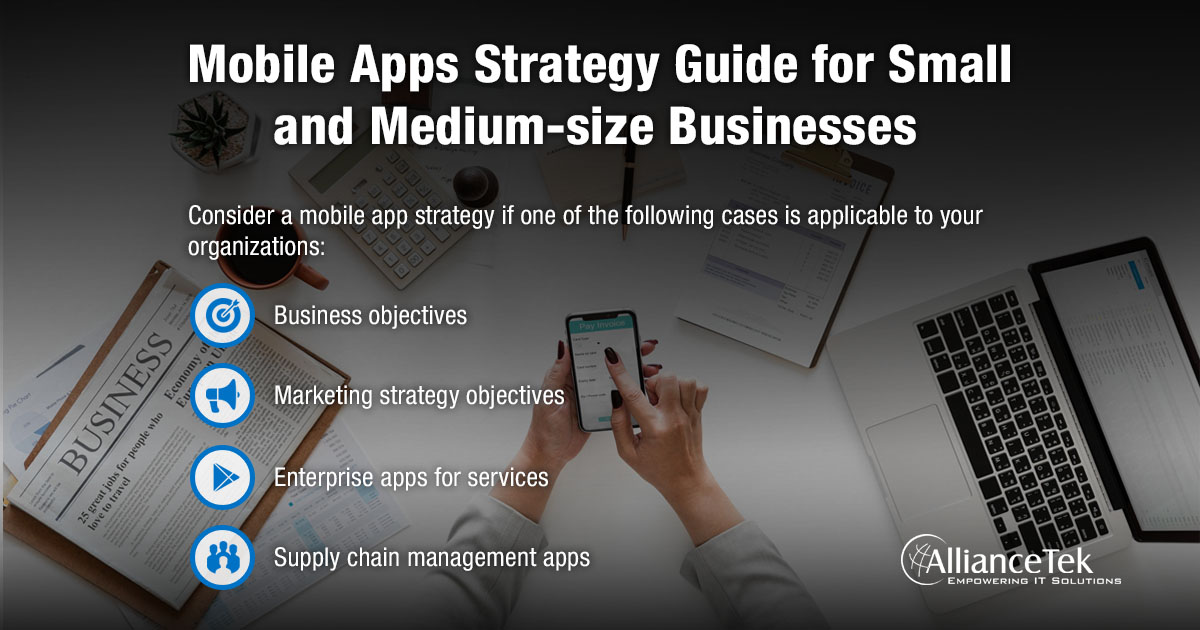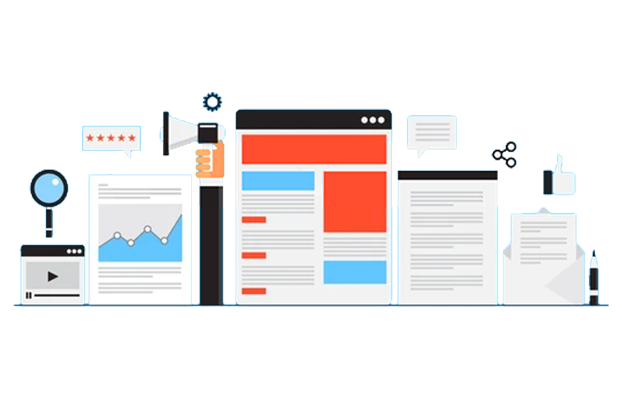While many small and medium-sized companies aren’t sure how adopting mobile technology and enterprise apps might help them, those who have adopted it, find it difficult to realize its full potential.
It is important to know that can only be a success once organizations and companies run it to supplement the overall business objective. It can run in sync with the existing business model of the company. All too often, a stand-alone mobile strategy often ends up as nothing but an expenditure, without any tangible returns on investment.

How Does Your Mobile App Strategy Affect Your Organization?
Stakeholders in your organization can be broadly divided into two categories namely, internal and external ones. While the external stakeholders include customers, communities, suppliers and partners, creditors and the government, internal stakeholders are the employees within the organization.
While most of the obvious investments and expenditures in any organization keep in mind the external stakeholders who directly affect the company’s revenue and increase sales, internal stakeholders are equally important. These stakeholders benefit the bottom line by streamlining the expenditure and eventually making the system more robust to sustain and grow the profits for you.
Your enterprise app mobile strategy could be affecting either the external or internal stakeholders or both in some way or another. We will be discussing in what ways this technology can be transforming your business and how to go about it.
When to Apply a Mobile App Strategy
A mobile app strategy should be considered when a business or organization wants to engage with their audience through a mobile platform and provide them with a more personalized and convenient experience. Here are some situations where a mobile app strategy may be appropriate:
1. Business Objectives
A mobile app strategy can be an effective tool for streamlining and automating business processes. It allows for the real-time exchange of data, status updates, and communication among various internal stakeholders. The app can facilitate one-to-many, one-to-one, and many-to-one communications at a negligible investment.
In addition, a mobile app strategy can help reduce lead time, increase the number of work completed within service level agreements (SLAs), and minimize errors due to communication gaps. This can be achieved by providing a bonus for each task to each of the process owners, which can motivate them to complete their tasks on time and with greater accuracy.
Moreover, the data from the app can be fed into analytics to provide insights into the effectiveness of the processes and identify areas for improvement. This can help organizations make data-driven decisions and optimize their business processes for better efficiency and productivity.
It is important to consider both online and offline functionalities while designing the mobile app strategy. While online functionality allows for real-time business communication and data exchange, offline functionality can ensure that users can access the app and its data even when there is no internet connection.
2. Marketing Strategy Objectives
Mobile tools can be an effective way of increasing your sales. If your organization is into B2C selling, this can be very powerful to consider whether or not your customers' mobile technology is good.
- Convenience: Your customers carry their mobile devices with them, not their television, or any billboards. This means that you can target them wherever they are, while you are equipped with all their data including where they are travelling, their cookie information regarding their behaviours and potential demands.
- Personalization: A mobile phone is often considered the only medium organizations can reach out to their customers with, providing personalized offers they would not be ready to accept via any other channel. Tailor-made offers based on behavioural and purchase profiles are possible on a mobile app without having your competition know about it.
- Cost-effective promotion: SMS and notifications are a great means to promote your offers at a cost that is negligible with a great ROI for the campaigns. The objectives of the campaigns can be far from flash sales and result in keeping your brand right on top of the consideration set among your prospective buyers.
- Secret loyalty program: Users who make downloads on your app and make a purchase are generally more consistent customers than ones buying from your website. Nurturing this highly engaged customer base and offering them unique loyalty programs can be possible on your app.
3. Enterprise Apps for Services
Enterprise apps for services can help organizations improve coordination and communication between field agents and back-office staff. Here are some key features and benefits of such apps:
- Automatic Allocation of Service Tickets: The app can automatically allocate service tickets to the relevant field agents based on priority and location. This helps in optimizing the scheduling of tasks and reducing the lead time for service delivery.
- Real-time Geolocation Mapping: The app can provide real-time geolocation mapping for field agents, which helps them to navigate to the service location and optimize their travel routes. This also helps back-office staff to track the progress of service delivery in real time.
- Auto-Submission of Attendance: The app can enable field staff to submit their attendance automatically when they reach the service location. This eliminates the need for manual attendance reporting and reduces administrative overhead.
- Status Report: The app can provide status reports to back-office staff to identify which process is causing bottlenecks in service delivery. This helps in identifying the areas that need improvement and optimizing the service delivery process.
- Coordination with Service Agents at the Office: The app can facilitate coordination between field agents and back-office staff. This helps in resolving issues quickly and efficiently.
- Evaluation of Performance: The app can help in evaluating the performance of field agents based on their service delivery metrics. This can help in identifying the areas where training and development are needed.
- Video/Voice Call for Coordination: The app can facilitate video/voice calls between field agents and back-office staff for quick resolution of issues. This helps in improving communication and reducing service delivery lead time.
- Knowledge Material Sharing: The app can enable field agents to access knowledge material required to solve a particular issue along with the case when he/she visits the site. This helps in improving the quality of service delivery and reducing the lead time for issue resolution.
- Reduction of Calling Agents' Cost: With an engaging app, the user directly raises and solves the issue via the enterprise app and its chat facilities along with the provision to upload photos regarding the issue. In this case, the user prefers easy resolution of issues without having to call a human agent further reducing the service expenditure of the company.
4. Supply Chain Management Apps
An enterprise app for supply chain management is a comprehensive software solution that connects different elements of the supply chain and provides real-time insights into the operations. It can help streamline and optimize the supply chain, which is crucial for businesses operating in industries such as retail, manufacturing, or assembly.
Here are some key features and benefits of an enterprise app for supply chain management:
- End-to-End Visibility: The app can provide end-to-end visibility of the supply chain, which helps in identifying bottlenecks, scaling operations, and improving overall efficiency. It allows businesses to track the movement of goods and materials from suppliers to customers, and everything in between.
- Inventory Management: The app can help manage inventory levels by tracking stock levels and demand forecasts. It can also provide alerts when inventory levels are low, enabling businesses to order more stock before they run out.
- Demand Planning: The app can help businesses plan for future demand by analyzing historical data and market trends. This helps in ensuring that the right products are available at the right time and in the right quantity.
- Supplier Management: The app can help manage suppliers by providing insights into their performance, delivery times, and quality of goods. This helps in identifying the best suppliers and negotiating better deals.
- Customer Relationship Management: The app can help manage customer relationships by providing insights into their buying behaviour, preferences, and feedback. This helps in improving customer satisfaction and loyalty.
- Cost Optimization: The app can help optimize costs by identifying areas where costs can be reduced, such as reducing inventory levels, consolidating shipments, or improving transportation routes.
Execution Guidelines
The execution has to be well-planned and drafted specifically for the company's needs. Licensing of existing apps often poses the problem of being different from the business processes in your organization, eventually causing a failure in the implementation of the app.
Enterprise app security is of utmost importance for any organization as it will be the conduit for valuable data you do not want to leak.
- Study your competition for the features and strategy.
- The data flow of the app is integrated with the rest of the analytics system and has to be analyzed and assimilated into the business decisions.
- Brainstorm with the potential users about the kind of features they might be appreciative be off before making the final draft of the plan
- Planning your enterprise mobile app must always be futuristic possibly with AI, and options to customize UI.
- Once you have identified the need for a mobile strategy within the organization, the implementation starts. It is always advisable to have only one enterprise app for a particular group of stakeholders. The major difficulty arises as companies mix multiple functionalities in one mobile app as it not only reduces the usability of the app but reduces the app's accountability. Your mobile app solution can be in cluster architecture as well where the smaller apps are connected to a larger one.
- Do and re-do your enterprise app iteratively based on your user experience feedback.
Final Words
A mobile app strategy can be a valuable tool for small and medium-sized businesses to engage with customers, improve internal operations, and gain a competitive edge. To develop an effective mobile app strategy, businesses should identify their goals, target audience, and desired functionalities.
They should also consider the online and offline functionalities of the app, as well as the investment required for development and maintenance. A successful mobile app strategy can lead to increased customer engagement, improved efficiency and productivity, and better customer satisfaction. By leveraging the power of mobile technology, small and medium-sized businesses can expand their reach, enhance their brand reputation, and achieve their business objectives.
Call us at 484-892-5713 or Contact Us today to know more details about Mobile apps strategy guide for small and medium-size businesses


